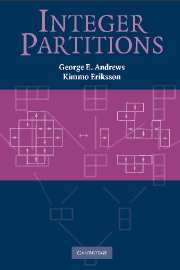Book contents
- Frontmatter
- Contents
- Preface
- 1 Introduction
- 2 Euler and beyond
- 3 Ferrers graphs
- 4 The Rogers-Ramanujan identities
- 5 Generating functions
- 6 Formulas for partition functions
- 7 Gaussian polynomials
- 8 Durfee squares
- 9 Euler refined
- 10 Plane partitions
- 11 Growing Ferrers boards
- 12 Musings
- A On the convergence of infinite series and products
- B References
- C Solutions and hints to selected exercises
- Index
2 - Euler and beyond
Published online by Cambridge University Press: 05 June 2012
- Frontmatter
- Contents
- Preface
- 1 Introduction
- 2 Euler and beyond
- 3 Ferrers graphs
- 4 The Rogers-Ramanujan identities
- 5 Generating functions
- 6 Formulas for partition functions
- 7 Gaussian polynomials
- 8 Durfee squares
- 9 Euler refined
- 10 Plane partitions
- 11 Growing Ferrers boards
- 12 Musings
- A On the convergence of infinite series and products
- B References
- C Solutions and hints to selected exercises
- Index
Summary
In this chapter, we will show how identities such as Euler's, and many more, can be proved by the bijective method. However, although the bijective method is elegant and easy to understand, it is not the method Euler himself used. Euler worked with an analytic tool called generating functions, which is very powerful but demands a bit more mathematical proficiency. We will return to Euler's method in Chapter 5.
Highlights of this chapter
We introduce basic set theory: union, intersection, and cardinality of sets.
We show how bijections (one-to-one pairings of two sets) can be used to prove identities.
A bijective proof of Euler's identity is given (the number of partitions into distinct parts equals the number of partitions into odd parts) using merging of equal parts, the inverse of which is splitting of even parts.
Euler's identity is generalized to other “Euler pairs,” that is, sets M and N such that the number of partitions into distinct parts in M equals the number of partitions into parts in N.
Set terminology
We will need some concepts from set theory. In particular, a set is a collection of distinct objects, usually called elements. We can describe a set by listing its elements within curly brackets. For example, {1, 2, 4, 5} is a set of four elements, all of which are integers. It is important to remember that the order of the elements implied by the list is not part of the set; thus the lists {4, 5, 2, 1} and {1, 2, 4, 5} describe the same set.
- Type
- Chapter
- Information
- Integer Partitions , pp. 5 - 13Publisher: Cambridge University PressPrint publication year: 2004



